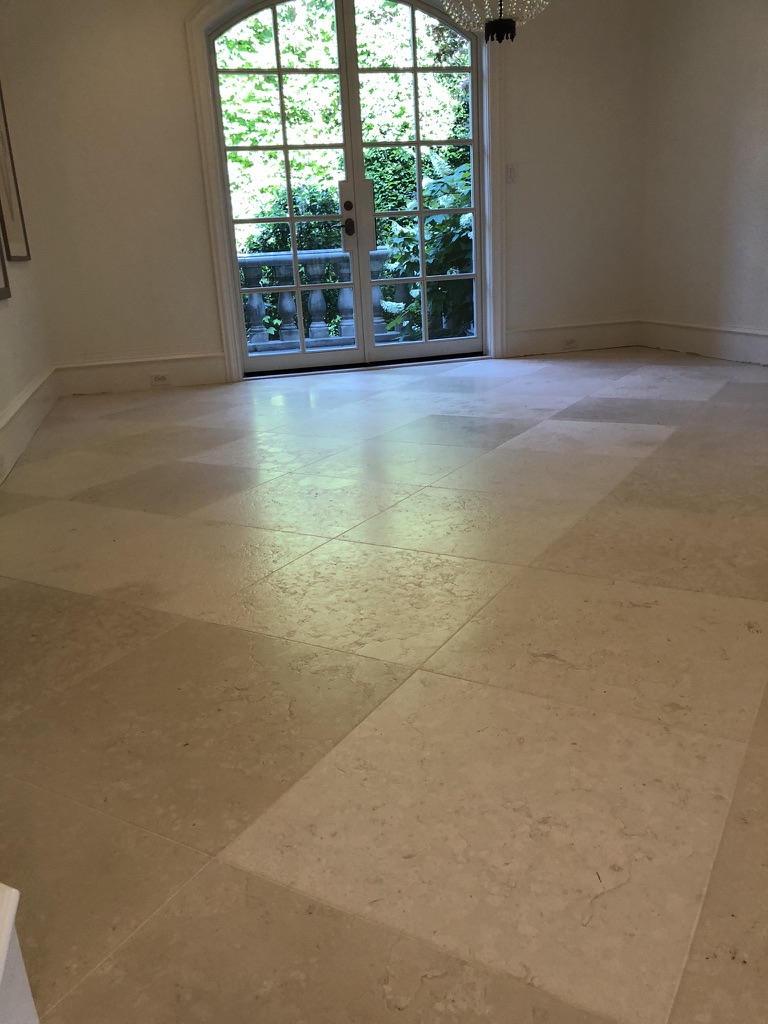
Limestone Floor Restoration
Limestone floors may stand the test of time however they still are susceptible to dirt, dust and grime. Therefore and without a doubt, limestone floors must be properly maintained using the correct cleaning procedure. Below you will find some helpful tips and recommendations on how to care for it. Floors that have been around for a while will first need to be repaired and adequately sealed. Limestone flooring has great stamina as long as it’s properly maintained and cared for.
Here is some sound advice for helping to keep your Limestone floors looking their best every day. First off, cleaning limestone floors might appear a little tedious however once you get the hang of it it’s really quite simple. These same tips will apply to cleaning your limestone whether it is in a commercial building or residence. The first rule of thumb is to be sure to quickly clean up any spills from acidic liquids such as tomato juice, vinegar, grapefruit juice, etc. Also limestone flooring is susceptible to water stains from leftover puddles after mopping or setting a glass water on the floor. What you want to do is clean your limestone surface using a very soft cloth or mop containing a pH neutral solution. Be sure to quickly wipe off spills on the floor as soon as they happen and we cannot stress enough never to use vinegar on a marble floor as this will thoroughly destroy its finish. Apply the cleaner first. After which dry mop the floor to ensure there are no puddles.
For difficult stains you should CONTACT US rather than risk it yourself. If you do see difficult stains on your floors attempt to decipher if the stain is a water-based stain or if it’s from an oil based product. If the stain has sat on the floor for a long time it may be necessary to re-finish that section of your floor with a specialized piece of cleaning equipment. After your limestone flooring is clean you could keep it looking its best with a maintenance schedule by using a neutral cleaner as mentioned specifically for cleaning it. Of course you do want to read the directions to determine the correct dilution ratio so the cleaning product is not too strong.
Using good preventative maintenance will make the job a lot easier and if done right a simple dust mopping will pick up dirt and dust not collected by the mats. In closing, marble floors are beautiful and will continue to stay that way with proper maintenance.
Limestone Restoration Questions
Signs such as dullness, scratches, or stains indicate the need for restoration. Consulting with a professional for a thorough evaluation helps determine the appropriate restoration plan.
Yes, limestone floor restoration often includes color enhancement to bring out the natural hues and patterns. Specialists use specialized sealers or enhancers for this purpose.
Professional restorers have the expertise to assess and repair cracks or chips in limestone, ensuring a seamless appearance after restoration.
Yes, eco-friendly sealers and cleaning products are available for limestone floor restoration. Professionals can provide sustainable options aligned with environmental considerations.
Using pH-neutral and non-abrasive cleaning products is crucial to avoid damaging the sealer. Professionals often provide recommendations for suitable cleaning agents to extend the life of the restored limestone floor.
Professional restoration can address issues like uneven surfaces or lippage by honing or grinding the limestone to achieve a consistent, level appearance.
After restoration, professionals may recommend preventative measures such as using rugs or mats in high-traffic areas and advising on proper cleaning practices to minimize wear.
Regular sweeping, damp mopping, and using pH-neutral cleaners are recommended for maintaining limestone floors post-restoration. Periodic reapplication of the sealer helps preserve the restored surface.
Yes, specialists often specialize in working with historic limestone floors, preserving authenticity while addressing issues such as erosion or deterioration.
Factors such as the size of the area, the extent of damage, and the specific services required influence the cost. Obtaining a detailed quote from a professional after a thorough assessment is recommended.
Remember that it’s essential to consult with a professional at Total Floor Care for an assessment of your specific limestone floor and to get tailored advice on the restoration cost, process and maintenance.
Do's and Dont's of Limestone Floor Maintenance
DO clean up spills immediately to minimize damage to your stone.
DO use trivets or mats under hot dishes and cookware.
DO use place mats under china, ceramics, silver and other objects that can scratch the stone’s surface.
DO use coasters under glasses, especially if they contain alcohol or citrus juices.
DO use a tray for toiletry products in the bathroom to protect the surface from the damaging chemicals contained in many toiletry products.
DO dust mop your limestone floor tile regularly.
DO use door mats inside and out along with runners and area rugs on limestone floors.
DON’T wait to clean up spills on stone.
DON’T use cleaners that contain acid such as bathroom cleaners, grout cleaners or tub cleaners.
DON’T use vinegar, bleach, ammonia or other general-purpose cleaners.
DON’T use abrasive cleaners such as dry cleansers or soft cleansers.
DON’T use alkaline cleaners not specifically formulated for stone.
DON’T use scouring powders and abrasives because they will scratch the surface















